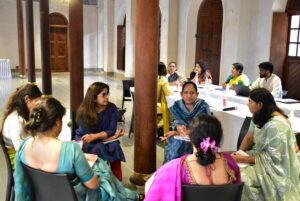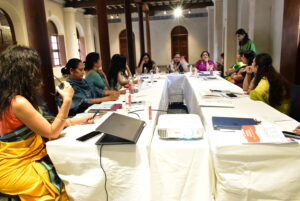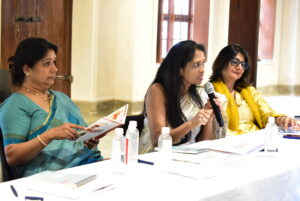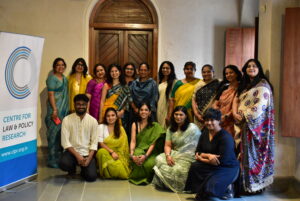
On March 22nd, 2025, the Centre for Law and Policy Research (CLPR) organised a Roundtable in Bangalore with senior women lawyers practising in the Supreme Court of India. The consultation was part of CLPR’s ongoing initiative to address the systematic barriers and propose reforms to enhance women’s representation in the higher judiciary.
Senior Advocate Jayna Kothari (Executive Director, CLPR) presented the key findings of CLPR’s research. The data highlighted persistent gender disparities in judicial appointments to the Supreme Court – very low numbers of women appointed, exclusion of women from the Bar, short tenures, opaque selection processes and exclusion of women lawyers from key constitutional roles. The consultation facilitated a solution-focused dialogue with actionable strategies to improve visibility, opportunities, representation and influence for women in the legal profession.

Recommendations for Institutional Reforms
- There was a clear need for reservation of 33% women in the higher judiciary, similar to reservation in the legislature which has been introduced and the need for implementation of the Memorandum of Procedure (“MoP”) that recommends 33% women in the higher judiciary.
- To introduce a constitutional amendment similar to South Africa mandating gender and caste representation in the higher judiciary in proportion to the population.
- To mandate 33% reservation for women in all government panels, as law officers and in PSUs, government departments States that have service rules for law officers, the Rules should be amended to include 33% women.
- For singular high-ranking posts (eg. SG, AG, ASG), where a 33% reservation is not directly applicable due to the nature of the position, a rotation model can be mandated to have women appointed to these positions on a rotation of 2:1.
- The Bar should proactively prepare and submit lists of qualified women lawyers for appointments to the Collegium.
- The Collegium should also create Search Committees to identify and recommend women for appointments.
- Institutionalise and maintain a 2:1 Bar-to-Bench ratio for women’s appointments.
- A re-evaluation of the current collegium system was needed and a new Judicial Appointments Commission law needed for accountability, transparency, clear selection criteria and public trust in the process.
- Adopting a formal application-based judicial appointments process with defined eligibility and evaluation criteria. Additionally, establish a mechanism to flag potential candidates for consideration.
- Mirror the senior counsel designation process with the objective and merit-based application process and include the marking and performance data.
- Include an option in the senior counsel application for expressing interest in judicial roles.
- Equalise the age of retirement across High Courts and the Supreme Court judges to extend women’s tenure.
- Consistently track and publish appointment data disaggregated by gender and social background.

Increasing Visibility of Women Lawyers and Pathways to Leadership
Participants emphasized that women lawyers in the Supreme Court, despite their competence and capabilities, were not being considered for judges to the top Court. To enhance their pathways to leadership, a range of strategies were proposed:
- To establish national forums for women lawyers on mainstream legal subjects such as constitutional and commercial law to enhance their expertise and this should be beyond gender-centric issues.
- To demand that 50% of all appointments of amicus curiae, and lawyers as mediators and legal aid panels are women, to increase the visibility of women lawyers.
- Judicial committees should appoint women, and not only for women focussed issues but on other focus areas as well.
- Encourage Bar Associations to adopt visibility-enhancing measures for women lawyers as all women lawyers may not have visibility before the collegium judges;
- Form a national network of women lawyers and establish an All India Women Lawyers’ Association.
- Use of strategic litigation to increase women’s leadership roles.
- Collaboration with legal media platforms (eg, Bar & Bench, Livelaw & SCO) to feature women lawyers in the media.
- Promote mentorship by senior women lawyers to support younger professionals.
- To create a conducive working environment with better infrastructure, maternity benefits and, creche facilities to ensure retention of women in the profession.
Political and Public Advocacy
- Develop and circulate a White Paper with data and recommendations to Bar Councils, Judicial Academies and Ministries.
- Engage women legislators to bring gender diversity in the judiciary into political discourse.
- Advocate for government and male allies to push for structural reforms.

Outcome & Next Steps
The Roundtable concluded with the call to action to implement all the strategies suggested. They agreed that a White Paper should be developed, compiling key findings and recommendations and should be presented to the Supreme Court Collegium and national bodies. The Roundtable marked a significant milestone in the advocacy for equal representation of women in the higher judiciary. It strengthened the network of women lawyers working towards reform and transformation of the Indian Judiciary.

